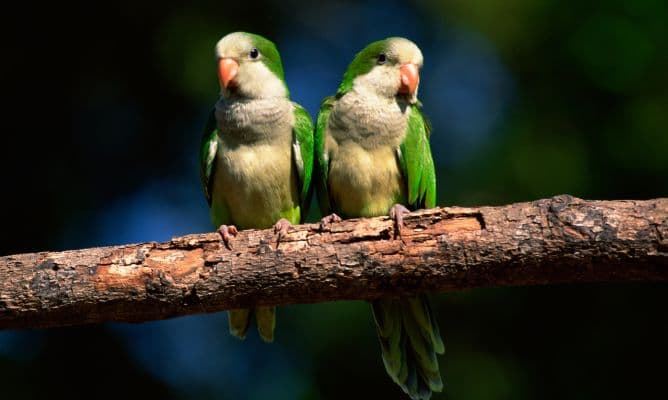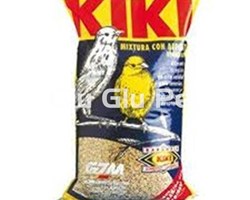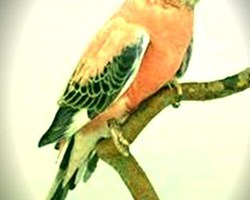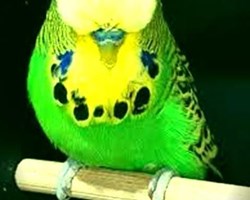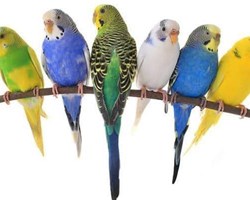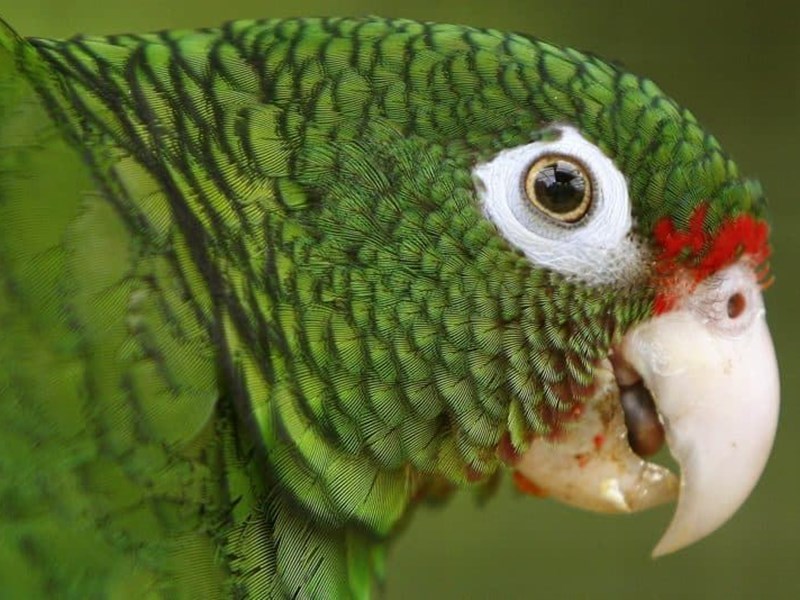
1.- DESCRIPTION OF THE PARROTS.
2.- TYPES OF PARROTS.
3.- BEHAVIOR AND COMPATIBILITY.
4.- FROM GLU GLU PET WE ADVISE YOU HOW YOUR PARROT CAN TRUST YOU.
5.- HOW TO LET YOUR PARROT BE OUT OF THE CAGE.
6.- WHICH IS THE BEST CAGE FOR YOUR PARROT.
7.- WHAT IS THE BEST SITUATION OF THE CAGE AT HOME.
8.- HOW TO CLEAN THE CAGE OF YOUR PARROT.
9.- THE BEST FOOD FOR YOUR PARROT.
10.- THE COMMON DISEASES OF THE PARROTS.
11.- HOW TO TEACH A PARROT TO TALK.
12.- HOW THE PARROTS REPRODUCE.
1.-DESCRIPTION OF THE PARROTS:
The parrot, better known as Cotita, is native to South America, its place of origin being Argentina, but habitats of this bird have also been found in countries such as Paraguay, Bolivia, Uruguay and southern Brazil.
It is an animal that usually lives in forests and mountains, as well as in more open spaces.
It is one of the few birds that are able to adapt without problems to sudden changes in temperature.
In some countries, colonies have formed in cities, which has been a big problem for residents due to their loud chirping.
It is a bird classified as medium size, having a length of about 29 centimeters from head to tail. It usually has a weight of around 600 – 900 grams depending on the species.
It is characterized by having a round head with a curved beak and a stepped tail, which helps to differentiate it from the rest of its distant relatives, the parrots. The plumage is very colorful, with green as the predominant color, but it is also possible that there are variants with turquoise tones. Its legs are strong and its nails are adapted to be able to climb trees without any problem.
Since there are no great differences between male and female, it is very difficult to differentiate one from another except for a DNA test. Some breeders claim that males are larger than females, but in some subspecies of the parrot the opposite is the case, so using this technique to differentiate them does not work.
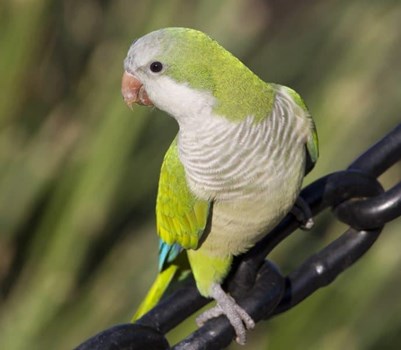
2.-TYPES OF PARROTS:
Within the types of parrots we can find a diversity of species all with different characteristics but they always have in common their intelligence, love, charisma, dexterity and almost all of them are talkative or can emit one or another word if they are well domesticated and trained for these feats. . They are playful and love to receive affection from their owners, in their habitat many of them are sociable and like to walk in small groups or flocks, looking for their food. Among the types of parrots we can find.
Common Parrot.
This parrot measures approximately 28 to 31 centimeters and weighs about 140 grams. Its plumage is of an intense green color, but it has a gray color on the part of its face, forehead, neck and abdomen and its bluish-green wings. They have a long tail, their beak is strong and thick, their flight is straight, they are loving, they live in groups and for this they prefer places with a warm or temperate climate. Their nests are made with twigs and are collective. To mate, the male always incites the female with peculiar courtships, his diet is based mainly on fruits, corn, rice, flowers, fruits and all kinds of seeds.
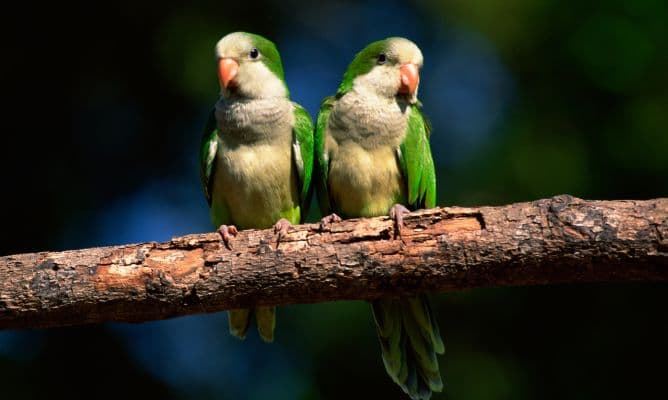
Sun Parrot.
Among the types of parrots we find the striking sun parrot, a bird native to South America with beautiful colors that predominate in its plumage, generally young people have it green but over time they change to yellow, orange, and reddish colors that they have in the tail, abdomen and head. This beautiful parrot is easy to tame, it measures approximately 17 to 30 centimeters and weighs approximately 120 grams. The female only lays 3 to 5 eggs, of which only 3 or 4 hatch, feeding on all kinds of fruits and small seeds.
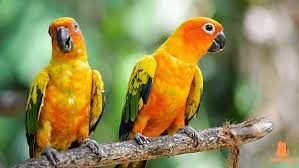
mountain parrot
We get among the types of parrot this species that is very striking, it is also called rusty-faced parrot, we can locate it in areas such as the Andes, in Colombia, Venezuela and Ecuador. The colors of its plumage are a spectacle on the face and forehead we can see a rusty red tone but from behind we find an olive green color, the shoulders are dark red, on the back green feathers, on the wings the lower part is blue but below light green, when it flies we see a black to dark blue color, its tail is red and blue at the tip, mustard yellow chest and throat, its strong gray beak measures approximately 24 centimeters, it feeds on fruits, flowers and seeds.
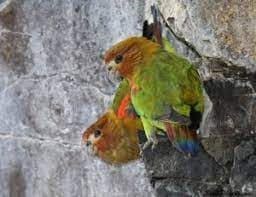
Alexandra's parrot.
This parrot is also called princess parakeet, it is a medium-sized bird that measures approximately 34 to 46 centimeters, on its plumage it can be said that it is green, the throat is pink, the crown is blue, the tail is long and pointed, its wings narrow but long. The flight of the Alexandra parrot is undulating, it occupies most of its time perched on the ground looking for its food, which are seeds, herbs, berries, flowers, among others. Of these species, the Alexandra parrot is not very noisy, its calls are soft and not harsh.
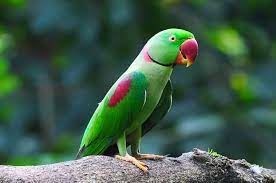
Malabar parrot.
This parrot has a species and particular plumage since by the combination of its tones, in addition to giving it beauty, it serves as camouflage between the trees and leaves. It can be found in mountain forests, it usually travels in groups or small flocks, its flight is horizontal and fast, its diet is based on buds, nectar and flower pollen, and nuts and fruits such as figs and berries. It can also be seen in crops feeding on cereals, peas and fruit trees. Among the species of the types of parrots, this one is quite noisy, its calls are usually sharp. Watch this video of all kinds of parrots.
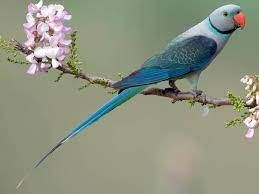
3.- BEHAVIOR AND COMPATIBILITY:
There are not a few who have chosen to have a parrot at home as a companion. She is not a bad companion, on the contrary, she is the ideal pet thanks to her affectionate nature and the ease with which she adapts to different environments.
In addition, he knows how to live with other companions of the same species and even with other birds.
They are great talkers, as they have a great ability to remember words and even entire phrases. They are great fun in everyday life and can sing and imitate sounds. But for those who like animals that only talk "from time to time", perhaps this bird will be a real headache.
The general life expectancy of a parrot ranges between 15 and 20 years in captivity, although some specimens have been seen, such as the Argentine parrot, which have reached 30 years.
4.- FROM GLU GLU PET WE ADVISE YOU HOW YOUR PARROT CAN TRUST YOU:
Being animals that adapt easily to the conditions of the environment, it is not difficult for them to have a good life expectancy, but it requires a lot of care so that it is as long as possible.
It is true that the parrot is a very affectionate animal and that it immediately gains confidence with the human being. But, this does not mean that on the first day it will bring its head closer to its owner so that it can be caressed.
No, the first thing that is needed is to establish the first contact. Since she will be in a strange environment, it will be normal for her to be a little nervous, so you have to leave her alone for a couple of days so that she gets used to seeing people pass by the house. Locate it in the center of greatest activity in the house, where you spend more time. This way he will get used to the presence of the different members of the family.
After a couple of days you can gradually approach his cage, not only to feed him, but also to tell him something, like his name. This way you will catch their attention. Little by little, he will react to seeing you and show signs of being happy that you are near the cage. With the passage of time, something that can take a week or a month, will approach the bars when it sees you appear so that you pay attention to it.
If what you want is to be able to let her out with complete peace of mind, here you are going to have to work a little more. The first thing is to open the cage and get your hands on one of your favorite treats. The safest thing is that the first time it goes away. Stay for about 5 minutes and if he doesn't listen to you, stick out your hand with the candy and close the door. Repeat the process each day until it finally comes close. Once he eats the candy for the first time, repeat the process for a few more days, until you can finally pet his back.
With this, you will only have to push it a little with your finger so that the parrot comes out of its cage and goes to perch on your finger. With this you can get it out of the cage. Though she may want you to put her down. In that case it is better to leave it back in the cage for now.
5.- HOW TO LET YOUR PARROT BE OUT OF THE CAGE:
Nothing forces you to have the parrot locked in a cage. In fact, there are many that end up living in freedom all their lives without any problem and they only need a perch on which to perch to sleep at night.
But keep in mind that later you may have problems if you have to keep her in a cage to take her to the vet. In the case of wanting to let her out of the cage, let it be little by little, so that she does not get too used to it.
Then, you can leave her longer and longer, as long as she understands that she has to go back into the cage later, for feeding time or bedtime. It is not good to get her used to eating outside the cage, as she may not want to go back inside later.
Remember that birds are much more susceptible than cats and dogs, so if the parrot doesn't pay attention to you, don't yell at it or try to catch it. Let her move around the house quietly, and then carefully place her inside the cage. You will appreciate it.
Of course, we must bear in mind that it is a bird that can take flight if it finds an open window, so if you want it to live loose in the house, you will have to cut its wings, even if it is cruel. But it's the only way to keep it from escaping.
6.- WHICH IS THE BEST CAGE FOR YOUR PARROT:
Actually it is very easy to choose a cage for parrots.
At Glu Glu Pet we have several models, we recommend which ones are the best:
- Size: Since parrots are a medium-sized animal, their cage does not need to be so large. 60 centimeters wide, 60 centimeters high and about 45 centimeters deep. With this, the bird will have more than enough room to move. If you have chosen to have two parrots, double the dimensions so that they do not have movement problems. In addition, the distance between the bars should never be more than 2 centimeters, thus preventing him from sticking his head between them.
- Materials: Lead or zinc must be avoided, which are harmful to birds, so the best option will always be stainless steel, which is much easier to clean.
- Shape: The shape of the cage is very important, the best are square or rectangular cages, which have some horizontal bars so that it can perch on the walls.
- Drinker and feeder: It is recommended that the feeder and drinker are placed on the outside, and the only door that there is is through which you can touch it when you trust it. If she tries to escape using the door to the feeder and drinker she could get stuck and do a lot of damage.
- Toys: Parrots also really like having toys, such as ladders or a rubber toy that they can chew on. But in no case should you put a mirror on them, as they can become attached to it and then feel very depressed when you take it away.
- Perches: With two or three perches the parrot will be happy. Plastic, metal or fake wood should be avoided at all costs, as they are not good for their legs. The hangers have to be made of natural wood so that you can sharpen your nails when you climb on it.
- Lock: They are quite intelligent birds, and opening a door that only has a latch is not a problem for them. You have to find a lock for the door that has a better security measure and prevents them from escaping so easily.
7.- WHAT IS THE BEST SITUATION FOR THE CAGE AT HOME:
Although the parrot cage is not large, it can be a real headache where to place it.
The cage should be in the same place where the most social activity takes place, such as the living room.
This is done so that it gets a little used to human contact.
When locating the cage, you will have to take into account:
- The cage should be at the same height as your eyes, since this way the parrot will not feel intimidated when seeing you or superior.
- Avoid at all costs areas of the room where there are quite a few drafts, such as a window, since in summer it is normal to open them and the parrot could catch a cold.
- It is not good to be in direct sunlight for many hours. Find an area that only receives the sun for a half hour at most.
- Two of the walls of the cage should be against the wall, so that the parrot sees you coming, which makes it easier to bond with her.
- Unlike other more sensitive animals, it is not all bad that the parrot is facing a television. In fact, this might help you learn a few words over time.
8.- HOW TO CLEAN THE CAGE OF YOUR PARROT:
You have to clean the base a couple of times a week to remove feces and food debris and the entire cage once or twice a month, it all depends on how dirty the bird is.
At the time of cleaning it, if the parrot is already used to moving around the house, it can be set free.
The first thing to know is that it is better to use bleach diluted in water, since it is a good disinfectant and thus you can clean the bacteria that are on the bars, using a brush.
Then soak and dry with a dry cloth.
9.- THE BEST FOOD FOR YOUR PARROT:
The general diet of parrots is based on seeds, branch shoots, insects and pieces of fruit.
At Glu Glu Pet you will find the best food and a product that you may like.
Keep in mind that this bird will consume two types of food: dry and wet.
There are all kinds, maintenance feed, low-fat feed to prevent fattening or a combination of seed, mainly sunflower, which is one of the foods with which they have been fed the most.
Although it must be taken into account that there are very picky cockatoos, and it is possible that they only want to eat seeds or another type of food.
You can also give them legumes such as beans, chickpeas or lentils, as long as they have been previously soaked overnight so that they are softer and they do not have so many problems eating them.
Giving it soft food is essential, although the parrot may not want it, it has to eat about 120 grams of this type of food a day, as it helps it receive the nutrients it needs to survive.
You have to give him a fruit and vegetable salad every day, so that he has a varied diet.
It is best to use apple, pear, kiwi, grape, orange, strawberry and red fruits, although peaches can also be used.
As for fruit, it is best to opt for lettuce, without going overboard because it can cause diarrhea, zucchini, carrots, green peppers or arugula, among other foods, so that you eat everything you need every day.
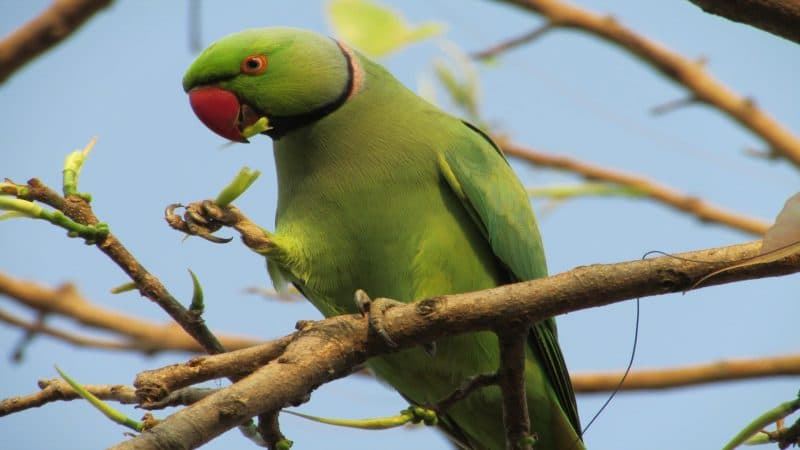
10.- THE COMMON DISEASES OF THE PARROTS:
Some diseases are very easy to treat, but there are others that can be deadly, so pay special attention to their symptoms.
The most common diseases in parrots are:
- Feather plucking: It is a behavioral disorder, but it could be said that it is like a disease since normally the plucking of the feathers itself is a sign that it has parasites. Although it is also possible that it does so out of boredom or lack of attention on the part of its owner. It can also be due to a lack of minerals in the diet.
- Abnormal feather fall: Parrots shed their feathers once a year and the fall is excessive, so there is no need to worry. But if it suddenly begins to lose feathers uncontrollably without it being its moulting season, that is because it is not having a good diet or it may have mites in the cage that incite it.
- Calcification: It usually occurs in older specimens and is due to having calcium salts in the scales of the skin. They find it difficult to walk and feel severe pain. You have to spread the affected areas with specific ointments.
- Deformations: When they are in their cage, the perches have to be made of wood so that they can file their beak and nails. Otherwise, it is possible that they have a great deformation in the beak, especially in the young, as well as excessively large nails, so you have to be very careful in this regard.
- Obesity: Parrots can also suffer from obesity if they do not eat a balanced diet. What's more, since many landladies have their wings clipped to prevent them from flying and spend most of their lives indoors, they can't exercise in order to burn off any extra calories.
- Aspergillosis: A serious disease caused by fungi, which are found in the seed or straw. You have to give seeds that are dry and have no traces of dust or mold in order to fight the disease or the bird could get worse in a very short time. Among the symptoms, it will be detected that he has difficulty breathing and that the air sacs are filled with pus.
- Respiratory infection: It is usually a common cold, especially when the parrot's cage is located in an area where there are strong drafts. In this case, it can be easily cured with antibiotics or thanks to pieces of fruit that contain a high content of vitamin C, such as oranges. But there are some more serious ones such as aspergillosis or ornithosis, in which case you have to go to the vet for treatment.
- Escherichia coli: This disease is transmitted when one of the birds in the cage is sick through feces. To prevent the parrot's cage from appearing, it has to be very clean, remembering that you have to do a general cleaning of it at least once. In the event that it is detected that a bird may have it, it must be separated from the rest, since it is very easy to spread.
- Salmonellosis: Diarrhea, joint pain and nervous disorders are the symptoms that parrots suffering from this disease usually present. Although symptoms can occur in other parts of the body. As with the previous one, it is a very contagious disease, so sick animals must be separated from healthy ones to avoid contagion.
- Colibacillosis: Sweating disease is how many know it, and the main symptom is that the bird has a wet and sticky belly area, in addition to its liquid feces. It can be easily transmitted from one bird to another and is usually fatal, so you have to separate the sick specimen from the rest to try to save them.
11.- HOW TO TEACH A PARROT TO TALK:
Listening to a parrot talk is one of the best experiences you can have.
The first thing you have to know is that, despite the fact that they are very intelligent animals and that they have a better ability to speak than parrots or macaws, you are going to need a little patience for them to learn to speak.
Remember, the first thing is to have earned your trust beforehand, so that the bird knows that it can trust you.
It is much easier for him to learn to talk when he is out of the cage than behind bars, because he will feel freer and more confident.
Divide the training into two parts: one in the morning and one in the afternoon, in sessions of about 15 minutes maximum.
Having all this clear, it is time to teach your parrot to speak, for which you will need to follow these steps:
- Get rid of distractions: The animal does not have to be distracted if you want it to learn to talk, so get rid of anything that can capture its attention, such as the radio, the television or music.
- Start with learning his name: It is best to start learning to say his name or that of his owner. For this you will have to repeat it to him, say "Hello, Charlie". Repeat the process every day. He may learn to say it in a week or a month or he may never do it and first he learns to imitate the sound of something he sees on television or another animal in the house.
- A reward when he does well: Giving him rewards is a very important part of the process, as it is a way of showing him that he has done well. When he says the first word, give him the trinket he likes the most and as he improves another one. But you have to alternate between candy yes and candy no, because if he sees later that you don't hit him, he may never want to say the word again.
- One at a time: When he learns to say a word, let him repeat it for a couple of days before moving on to the next or he may have trouble pronouncing them later.
12.- HOW PARROTS REPRODUCE:
Remember that there is no easy way to differentiate the male and the female, so you will have to resort to a DNA test to find out what sex the parrots you have are.
Once you know you have a male and a female, put them in a separate cage where they have plenty of food.
Normally, the male annoys the female quite a bit, offering her food, songs or squawks, as well as ceremonies to try to get her attention.
In the cage, place a wooden nest, which is the best for these birds, and once the process is finished, the female will settle in the nest and proceed to the egg-laying process, being able to lay up to 8 eggs. .
Once laid, male and female can take turns incubating the eggs, until the 21-25 days after the chicks hatch.
At birth, the young have no feathers, are deaf and blind, so it is the parents who proceed to feed them directly.
At two months the young leave the nest and begin to fend for themselves, so it would be the ideal time to separate them from their parents so that they can interact with other young of the same species and establish new relationships.
